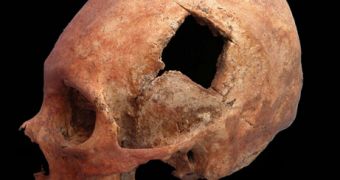One of the most developed pre-Columbian civilizations was the Inca empire, stretching through the highlands of Andes, in today's Ecuador, Peru, south Columbia, western Bolivia and northwest Argentina. The Inca civilization was outstanding because of its colossal architecture, its cities with paved and regular streets, sewage systems, roads, palaces, temples, but also the fortresses, agricultural terraces, irrigation ditches, and so on. Carving and cutting the enormous stone blocks were done without using iron tools! Moreover, the Incas were not familiar yet with the wheel.
Just recently, another amazing skill of the Incas has been revealed: they successfully performed trepanations, surgeries aimed at removing small parts of the patients' skulls to treat head injuries, as revealed by a new research published in The American Journal of Physical Anthropology.
Trepanation seems to have been used mainly to treat head injuries experienced by men during combat. Today, this surgery is employed to relieve pressure induced by fluid buildup caused by severe head trauma. Skulls found around Cuzco, the ancient Inca capital and dated around 1,000 AD, reveal no bone healing following the trepanation, which seems to have been mostly lethal. Still, by the 1400s, survival rates had come to know a growth of up to 90%, being accompanied by very low levels of infection.
"The new findings show that Inca surgeons had developed a detailed knowledge of cranial anatomy. Inca healers carefully avoided areas of the skull where cutting would be more likely to cause brain injury, bleeding, or infection. The operations were conducted without the modern benefits of anesthesia and antibiotics, but medicinal plants were probably used. They were aware of the medicinal properties of many wild plants, including coca and wild tobacco. These, along with maize beer, may have been used to alleviate some of the pain. Natural antiseptics such as balsam and saponins (plant chemicals forming a stable soapy froth in water) may have reduced the likelihood of infection following trepanation, " said lead author Valerie Andrushko, of the Southern Connecticut State University in New Haven.
The research team investigated 11 burial sites in the Cuzco area. 66 out of a total of 411 investigated skulls had holes cut through the skull, as left after trepanation. In one site, 21 of 59 skulls showed signs of this surgery. Inca surgeons employed the scraping technique to get through the skull without inducing wider injury. "The skull was slowly scraped away, resulting in a circular hole surrounded by a wider area of scraped bone," Verushko said.
Some patients underwent several trepanations; one man had 7 trepanation skull holes. In case the patient died during the trepanation surgery, the removed rectangular piece of bone was put back in its place before the body was buried. "It's astounding that [such a large percentage] of the population underwent skull surgery and that so many survived," said Tiffiny Tung, an archaeologist at the Vanderbilt University in Nashville, Tennessee.
However, trepanation was not restricted to South America, and it was found to have been practiced by people even during the Ice Age. In South America, the practice started as early as 400 BC, but no one can say if it was for medical or ritual/cultural purposes.
"With regard to the Inca (...) I think the authors are spot on when they suggest that cranial surgery was performed primarily to treat head injuries," said Tung. "Those injuries may have most often been sustained during warfare. Nearly all of the surgeries were performed either near the middle of the skull or on the left side - the regions most likely to be injured during combat with a right-handed opponent," Verushko added.
Moreover, some of the skulls presented signs of previous injury in the trepanation spot. Still, 19 of the skulls with trepanation holes belonged to women, in which case the surgery may have been performed in order to treat epilepsy or chronic bone infection.

 14 DAY TRIAL //
14 DAY TRIAL //